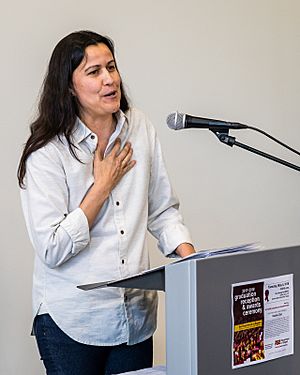Mojave language facts for kids
Quick facts for kids Mohave |
|
|---|---|
| Mojave Hamakhav |
|
| Region | Arizona and California, U.S. |
| Ethnicity | 2,000 Mohave people (2007) |
| Native speakers | 200 (2015 census)e19 |
| Language family |
Yuman
|
The Mohave or Mojave language is spoken by the Mohave people. They live along the Colorado River in parts of northwestern Arizona, southeastern California, and southwestern Nevada. Most speakers (about 70%) live in Arizona. The rest (about 30%) live in California.
The Mohave language is part of the Yuman language family. Other languages in this family include Quechan and Maricopa.
The Mohave language became an endangered language in the 1800s. This happened during a time called "Manifest Destiny" when the United States expanded westward. Mohave children, like many other Native American children, were taken from their families. They were sent to special boarding schools. At these schools, they were not allowed to speak their native language. Even when they visited home, they couldn't speak Mohave with their parents. Many parents did not speak English, which made things very hard.
Contents
How the Mohave Language Changed
In the 1800s, the United States grew westward. Settlers met more Native American groups. Often, these meetings led to fighting. The government saw Native Americans as a problem for their expansion.
To try and control Native Americans, the U.S. government started American Indian boarding schools. The goal of these schools was to make Native American children act like European Americans. This would weaken their native cultures. Children from ages 10 to 18 were sent there.
At these schools, children's hair was cut. They had to wear different clothes. They were taught English, math, and history. They also learned job skills. The Mohave tribe was affected by this. In 1890, the Fort Mohave Indian school opened. It served children from the Mohave and Hualapai tribes. This school stayed open until 1931.
Sounds of Mohave Words
The Mohave language has special sounds. It is similar to the Maricopa language. In the 1800s, Mohave speakers changed some sounds. For example, the sound like 's' in "snake" and 'sh' in "shack" changed. They became sounds like 'th' in "thick" and 's' in "snake."
Mohave Vowel Sounds
Mohave has five main vowel sounds. These sounds can be short or long. There is also a weak vowel sound, like the 'a' in "about."
- Close Vowels: Like the 'ee' in "see" or 'oo' in "moon."
- Mid Vowels: Like the 'e' in "bed" or 'o' in "go."
- Open Vowels: Like the 'a' in "father."
Listen to Mohave
Hubert McCord is one of the four leaders of the Mohave tribe. He speaks the Mohave language very well. He has worked with a poet named Natalie Diaz. They have written down Mohave stories and songs.
You can find a video online where Hubert McCord sings in Mohave. He sings while taking young people from the tribe on a trip. They travel around the Colorado River. This helps to share the language with new generations.
How Mohave Words Are Built
Morphology is about how words are formed. In Mohave, a basic word has one vowel sound. Other sounds, called consonants, can be added before or after the vowel.
Words are changed by adding parts called prefixes and suffixes. Prefixes are added to the beginning of a word. Suffixes are added to the end.
Mohave Tenses
Mohave verbs show when something happens. They have two main tenses:
- Present/Past: These are marked by adding suffixes like -k, -m, or -pc^.
- Future: This tense does not have a special marker.
The person doing the action is also shown.
- First person (I/we) usually starts with a '?' sound.
- Second person (you) starts with an 'm' sound.
- Third person (he/she/it/they) has no special marker.
Mohave Sentence Structure
Syntax is about how words are put together to form sentences. In the Mohave language, the usual word order is Subject-Object-Verb (SOV). This means the person or thing doing the action comes first. The thing receiving the action comes next. The action (verb) comes last.
For example, in a sentence like "Jim sold his brother a cow":
- "Jim" is the subject.
- "His brother" is the indirect object.
- "A cow" is the direct object.
- "Sold" is the verb.
The subject of a sentence often has a special marker called {-č}. Sometimes, parts of a sentence can be left out if the meaning is clear.
Here are some examples of Mohave sentences:
hatčoq
dog
ʔavi:-m
rock-with
ʔ-əta:v-k
1SG.SUBJ-hit-tense
I hit the dog with a rock
Jim-č
Jim-SUBJ
havik
sibling
kʷikʷay
cow
θinʸaʔa:k
female
sukam-m
sell-TNS
Jim sold his brother a cow
To make a sentence negative in Mohave, you can use different methods. One way is to add the suffix -mot- before the tense marker on a verb. Another way is to use the negative verb kava:r, which means "to not." Sometimes, the suffix -poʔa:ve is used with words like "anyone" or "anything."
Helping Mohave Language Grow

Since 2012, the Center for Indian Education at Arizona State University has been helping. They hold workshops for people learning Mohave and for those who already speak it. These workshops take place at the Fort Mojave Indian Reservation. This reservation is in Arizona, California, and Nevada.
About 22 older people on the Fort Mohave reservation still speak some Mohave. The project helps connect these elders with younger people. They teach traditional Mohave "bird songs." This helps keep the language and culture alive.
The language work of poet Natalie Diaz was shown on PBS NewsHour in March 2012. She works on the reservation to help save the Mohave language.

